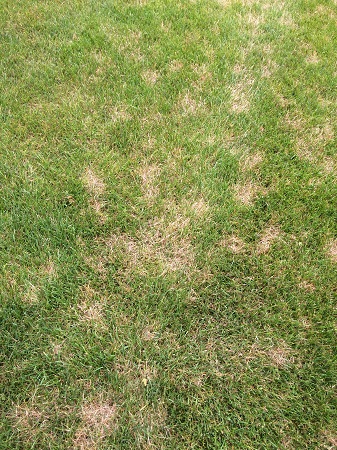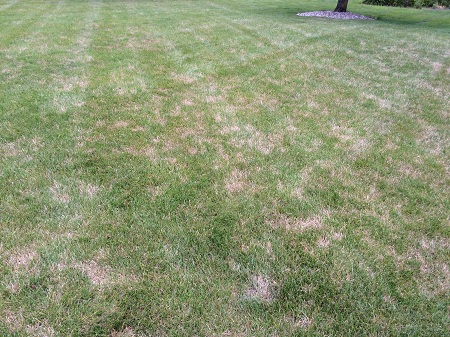
Insect & Disease
Dollar Spot
A very common lawn disease in the Illinois and Indiana area, Dollar Spot fungus is usually seen in the early and mid summer. Attacking many different types of grass, Dollar
Spot is generally seen in the lawn as 1” – 7” small straw-looking circles, or the size and shape of a silver dollar. Dollar Spot is a common, yet very serious problem in most lawns. When your lawn if affected by Dollar Spot, if left untreated it can kill the lawn all the way to the roots, which will defiantly be noticeable damage.
How Did I get Dollar Spot?
The short answer is your grass type was susceptible to the disease, which is the case for many Ryegrasses and Buegrasses. The more detailed answer is this: The Dollar Spot fungus requires temperatures above 60 degrees to start growing, usually in the spring, but the damage doesn’t start to show until summer. The disease likes water and requires periods where the leaf of the grass is wet for long stretches at a time.
There are many factors that help the Dollar Spot fungus pick your lawn, these are just a few:
- Heavy Thatch Layer (see Aeration)
- Watering Often For Short Periods (see How To Water)
- Heavy Dew At Night Sitting On The Lawn During Cool Nights
- Lots Of Wet And Overcast Weather
- Nutrient Or Nitrogen Deficiencies (see Fertilization)
- Drought Stress
- Poor Airflow Areas
- High Humidity
What Does Dollar Spot Look Like?
The small straw-colored circles, usually 1”-7” are how Dollar Spot starts, but over time the circles can grow together to form large brown areas of turf. These large, uncontrolled areas of disease infested turf can cause serious damage to a lawn, especially if left untreated. Another identifying sign is that the blade of grass affected by Dollar Spot also will have an hour-glass shaped spot on it. The spot will be the entire width of the blade and be tan with reddish brown on the top and bottom edge.
What Is The Treatment For Dollar Spot?
Suburban Landscaping has several fungicides to treat Dollar Spot, and our technicians will select the appropriate one for your lawn. Treatment is usually a liquid application of fungicide and often followed by a granular application of Nitrogen fertilizer, depending upon the situation. If your grass type is susceptible to Dollar Spot, an annual application would be a recommendation. A spring preventative is also available for lawns with high susceptibility. In addition to the basic treatment, Suburban Landscaping also records and monitors the fungicide applied to your lawn, mainly because of Dollar Spots ability to become resistant to fungicides if used too often.
What Can I Do To Help?
The best thing you can do to help in controlling Dollar Spot in your lawn is to water correctly. Water you lawn no more than three days per week, twice if possible. Water heavy to saturate the root system to avoid the need to water more frequently. Monitoring your thatch level is also a good tip. A heavy thatch layer is a breeding ground for this disease and should be reduced to around one half inch.
Does Dollar Spot Come Back Every Year?
In susceptible grass types it can definitely come back every year, especially if left untreated. If untreated, the fungus can over-winter as dormant mycelium, or fungal growth, in the thatch lawyer or soil.
What Does Treatment Cost?
This depends on the size of your property of course. However, because of the cost of the fungicide, it usually is $95 or more. The best way to know is to call our office for and estimate or request a free quote online.
Aphid Control
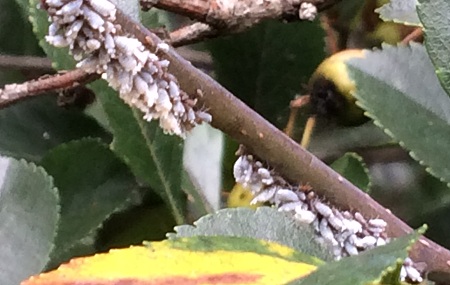
Aphids are a small, hard to see insect that suck the fluids out of plants for food. They are a slow moving insect, but they can multiply quickly. Usually found in large groups, the damage they can cause can be significant. All plants are susceptible to being eaten by one type of aphid or another.
Identifying Aphids
Most aphids are tiny, usually smaller than 1/8” long, and often go unnoticed by the human eye. Aphids can be many different colors, depending on the type, including white, black, gray, brown, light green, red, and yellow. All have pear shaped bodies with antennas. Some aphids have a wooly or waxy look to them (a secretion from the insect), and are usually identified by the same characteristic. For those who are very interested, the tell-tale signs of an aphid are long legs and two tubes rising backwards out of the tail end of the insect. Additionally, unlike other leaf eating insects, aphids are not skittish and don’t move too quickly when disturbed.
Aphid Damage
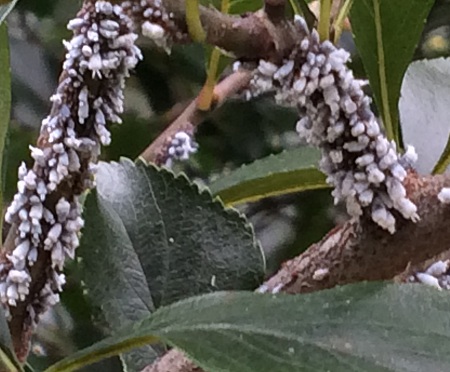
Both young and mature aphids damage your plants, both by feeding on the juices of the leaves stems and roots, depending upon the type of aphid. The new growth of a plant is usually the most susceptible part of the plant, with the woody limbs being less likely to be eaten. When looking for aphids, look for misshapen leaves or curling yellow leaves, often with a sticky substance (Honeydew) on the leaf. Often you will see other insects like ants which eat the Honeydew as food. Branches and leaves can also look black in color because the Honeydew can develop a fungus called Smooty Mold which can turn black with time. Rarely aphids can also cause galls to form on leaves and roots.
Aphid Control
There are two main types of control for aphids; chemical and biological.
- Our licensed technicians have several chemical insecticides that will treat your aphid infestation. Please call our office for an estimate.
- Biological control is somewhat difficult and not a service we offer. However, Lady Beetles are one form of biological control that is commercially available. Another biological control is to control the ant population that protects the aphids. Use a commercially available ant trap or sticker to control the ants, and natural predators such as wasps will be very helpful in aphid control.
Do-It-Yourself Aphid Control
A couple of methods for removing aphids from your plants or vegetables are easy and doable by homeowners.
- Spraying a stream of cold water onto the leaves and stems sometimes is enough to dislodge them from your plants.
- A mild solution of dishwashing soap (ivory) and water wiped onto the plant leaves and stems will get rid of aphids.
- Isopropyl alcohol will also dislodge most aphids. Mix it with water, or spray it straight, and spray the plant every two to three days for a few weeks.
- Lady Beetle control is also temporarily effective. If you choose this method, keep you Lady Beetles in a refrigerator and release them on your plants at dusk.
Apple Scab
Description
Apple scab is a common landscape disease that infects trees like Crab Apples and apple trees, know by the genus Malus. The disease is actually a fungus (venturia inaequalis) that show up as a dull black or grayish-brown lesion on the trees leaves and fruit. The underside of the leaves is the most common place to find Apple Scab lesions on a tree, although, sometimes, but not often, the lesions can also be found on the woody parts of the tree. Apple Scab doesn’t usually kill the infected tree, but it can cause serious damage and stunt the growth of the infected tree. What most people recognize as Apple Scab disease is the curling or scorching of the leaves (yellowing) and the early leaf drop that leaves an almost-bare tree.
Life cycle
The cycle of infection starts in the springtime, when warmer temperatures and spring moisture promote the release of the disease ascospores from leaves that litter around the base of previously infected trees. These newly activated spores rise into the air, blow around, and land on the surface of a susceptible tree, where they germinate, infect the tree, and start the cycle all over again.
Control
There are a variety of chemicals that can offer control on the sometimes annual disease. Some chemicals have been effective for years, and others are being less used due to resistance build up issues, such as Benzimidazole fungicides. There are also contact fungicides that work well for controlling Apple Scab, and are not prone to resistance issues. Other treatments such as copper mixtures are less effective, and can cause russeting on the fruit.
Apple scab is best controlled from late April through early June, which in Illinois and Indiana is the time from bud break to fruit setting. This is the time of year that the disease is airborne and can infect your trees. During this early time of year, Suburban Landscaping should be spraying your Crabapple trees for apple scab disease. Depending upon many factors, generally one to four applications are required to protect your trees.
What Does Apple Scab Treatment Cost?
Generally speaking, $30 to $90, depending upon how many trees you have. Most condominiums pay around the $30-$40 mark, while homeowners with one or two trees may pay around $80 - $90 per tree.
When Do You Apply Treatment For Apple Scab?
The fungicide treatment should start at the first sign of bud break, which is usually late April. Repeated applications should come every 7-10 days, if required.
Can I Treat Apple Scab In The Summer?
Not usually, but there are some new fungicides that show some promise. Treatment after the leaves have fallen off of the tree is usually too late.
Homeowner Tips:
Rake up and burn the fallen leaves from your infected crab apple every fall. This will prevent a reoccurrence of the disease from the same leaves. Also, dormant prune your crab apple trees in the winter to allow an open and airy canopy that allows leaves to dry and chemical treatments to penetrate.
Are All Crab Apples Susceptible to Apple Scab?
No. Below is a list of the Malus cultivars that are resistant to Apple Scab disease.
High Resistance:
- Bob White
- Louisa
- Prairie Maid
- Prairifire
- Redbud
- Red Jewel
- Sargent
- Silver Moon
- Sugar Tyme
- White Angel
Medium Resistance:
- Centurion
- David
- Donald Wyman
- Doubloons
- Harvest Gold
- Jewelberry
- Mary Potter
- Sentinel
Stay away from the following varieties that have a high susceptibility to Apple Scab disease.
- Adams
- Brandywine
- Indian Magic
- Indian Summer
- Profusion
- Robinson
- Snowdrift
- Velvet Pillar
Spider Mites
What Are Spider Mites?
The ubiquitous Spider Mite is a common pest in the landscape, but they are not insects, they actually have eight legs and are in the Spider family. The actual Spider Mite is so tiny that it is almost impossible to see without a magnifying glass. The most common way of identifying that you have Spider Mites is by the hard-to-see webs that they leave on your plants, in conjunction with the decline of the health of the plant.
Will Spider Mites Damage My Plants?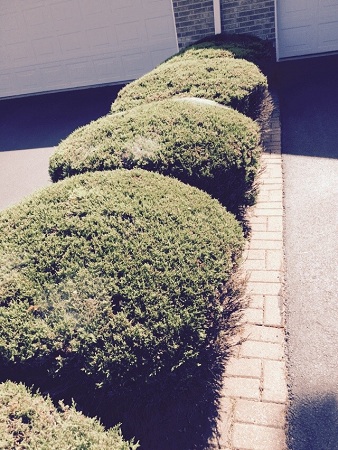
Yes. Spider Mites feed on the cell content in your plants by piercing the leaf and feeding on the green fluids that ooze out of the leaf. Heavy infestations can kill a plant within a month or two, depending upon the size of the plant. One an infestation begins, the plant will start to dull in color as the Spider Mite feeds, eventually turning a yellow or brown color. If the infestation continues, the branch or leaf takes on a gray or bronze color as the branch dies. This feeding will continue throughout the entire summer season, and will be most prolific during periods of drought.
How Can I Control Spider Mites Myself?
Yes, there are several things that property owners can do to reduce the damage that a Spider Mite infestation can cause. Chemical control is by far the best method of controlling Spider Mites. Many hardware/big box stores sell homeowner-accessible chemicals that will kill Spider Mites. Because come of these chemicals can also harm the plant that is hosting the infestation, you should read the label carefully to prevent doing any additional damage to the plant. Apply according to the instructions, and since the breeding season is all summer long, you will have to apply a few times during the summer season.
The more organic way of controlling Spider Mites is a very time intensive method. By using your garden hose with a jet nozzle attached, spray the webs from underneath to blast the webs, and therefore the Spider Mites, up into the air. This will kill the current batch of Spiders and eggs. This method will have to be do repeatedly during the summer, maybe even weekly.
To help minimize the damage to the plant that an infestation can cause, be sure to water the plant often during a drought period. See our page on watering plants during a drought for more information on shrub watering.
Can Suburban Landscaping Help Control Spider Mites?
Yes. Our State licensed technicians have access to restricted chemicals that homeowners are not able to purchase. The tools available in our arsenal include Miticides, dormant oils, and insecticidal soaps among others. Two applications approximately 10-14 days apart are required for best control. Choosing the correct landscape company to control Spider Mites is very important, primarily because using the incorrect insecticide not only will not kill the Spider Mites, but will kill their natural predators instead, causing the infestation to actually get worse. Please call our office, or fill out the online form, to request a quote for combating an infestation of Spider Mites in your landscape.
How Can I Identify A Spider Mite Infestation Myself?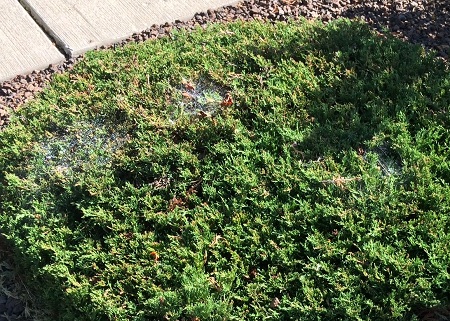
The easy way of diagnosing a Spider Mite infestation is to get a white sheet of paper and hold it under a branch of the plant. Then gently slap the branch onto the paper so debris falls onto the paper. Clear away the large debris and large bugs leaving only very mall debris. Next, swipe your hand over the debris on the paper, a red smear will appear if you have Spider Mites.
